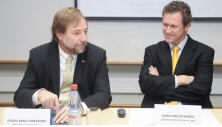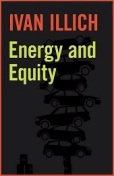To move from the unfair and hopelessly inefficient deadlock that is old mobility toward sustainable transport and sustainable cities, we need concepts, dialogues,  demonstrations, projects and programs. But none of this is going to happen if we don’t have the people: the warm, surely fallible but somehow thoughtful, daring and courageous human beings who are needed to bring all this about.We need more heroes, wouldn’t you agree? Our Profiles here on World Streets are intended to remind the world that whenever something good happens, it is because there are real live people behind it. Let’s take Robin Carlisle who is working for change in Capetown South Africa for example.
demonstrations, projects and programs. But none of this is going to happen if we don’t have the people: the warm, surely fallible but somehow thoughtful, daring and courageous human beings who are needed to bring all this about.We need more heroes, wouldn’t you agree? Our Profiles here on World Streets are intended to remind the world that whenever something good happens, it is because there are real live people behind it. Let’s take Robin Carlisle who is working for change in Capetown South Africa for example.
In The Headlights: Street-fighting man
– Profile by Gail Jennings, Editor, Mobility Magazine, Cape Town
In-between drags of his cigarette and stories about bicycle-commuting, Robin Carlisle, MEC for Transport and Public Works in the Western Cape Provincial Government, talks to Gail Jennings about his plans to get the province moving.
MEC Robin Carlisle states his position upfront: he doesn’t intend to change the world. That, he says, belongs in the realms of consultants’ fantasies; he merely intends to change direction, reverse our local trends in transport and re-align them with international trends. This, of course, will change for the better the personal worlds of multitudes of people in the Western Cape.
Current trends in South Africa are more roads, more cars, more congestion; decreasing air quality and increasing road fatalities (particularly pedestrians and passengers); and ‘magic fairy’ solutions appearing in provinces to the north. International trends are moving toward a re-definition of the problem: for as long as we regard long commutes, gridlock and spatial segregation and isolation as transport-problems, we’ll look for transport-related solutions…
The Western Cape, with MEC Carlisle in the driver’s seat, will be somewhere in-between, a damn-sight better place to be than where we are right now. Which is stuck in the traffic, losing time, losing money, and losing opportunities for economic growth and wealth.
Carlisle knows, and supports, the arguments for better spatial planning and densification of Cape Town in particular, which would bring people and work closer together. He admires the work of Jeremy Cronin, Deputy Minister of Transport and outspoken advocate of better land-use planning.
But his mission, his mandate, is to bring people to their places of work, no matter how far away these might be – easily, cheaply, quickly, in greater comfort and with greater dignity. And there’s something ‘Penalosa’ – another transport philosopher he admires – about the way in which he’ll do it, without excessive concern for ensuring his re-election.
‘We’ve set modest targets for modal shifts, but most importantly these signal a change in direction,’ he says. ‘Public transport will become more widespread, more accessible, and there will be a detailed, step-by-step scheme, within the next six months.’ This scheme, he says, ‘will be irreversible by 2014, around the time in which I retire!’

What will we see on the roads?
The nitty-gritty of the Western Cape’s transport plan, and its implementation strategy, has not yet been designed. But the overall philosophy is there: ‘What have I got? What can I add to it? And what can I take away later?’
‘Public transport is like a drowning person,’ says Carlisle. ‘You can’t just pull out a leg or an arm – you have to pull out the whole person. It’s a package, and is best developed sectorally.’
The key to Carlisle and his team’s system is connectivity, and it involves a combination of trunk routes, feeder services – reported in the local press as Bus Rapid Transit – and increased rail services. Funding will arise from the redirection of spend from road-building to public transport.
‘BRTs do have an important role – that of overcoming road-based congestion – but they’re not the magic solution. We don’t need to go and build new BRT roads; we simply need to take road space from private cars. This will come within about four years, you won’t be able to bludgeon your way into the rapid lanes unless you own a tank.’ Carlise leans back, takes out another cigarette and considers his retirement once more…
The formula is this: rail, trunk operators (‘probably buses’) and feeders (‘I see no reason why these can’t be modestly converted Quantums, running to a schedule and enjoying some sort of subsidy.’) ‘Licensed taxi operators don’t have to come into the system if they don’t want to,’ he points out. ‘There’s been no transport master plan so far because no-one wants to bite the bullet that is the taxi industry…’
And this is a bullet that Carlisle has already bitten: ‘These front teeth – I got these replaced after my first collision, on my bicycle on Wynberg Hill. My left shoulder, that was another close encounter …’ (Carlisle commuted by bicycle for more than 17 years, undeterred.)
‘I’m not afraid of the taxi industry, and I’m not going to prescribe to anyone. I need about 50% of the current licensed taxi industry to get the system going, and the smart guys will see the value in it – congestion has already cut some taxi mileage by up to 30%.’
How is it going to happen?
‘Funding and good managers: that’s what makes any project sustainable, and that’s what we’re going to get. It all starts with National Treasury, the sole conduit for 98% of revenue. This is where you have to contest for funding, and this is where I need to win the funding fight over the R300, for example. That will give us enough money, and if I give 50% to PRASA, this will fix our rail problems…’ The planned extensions to the R300, from Melkbosstrand in the north and to Ladies’ Mile Road on the M3 in the south, will cost an estimated R14-billion, which would be better spent on developing public transport infrastructure, says Carlisle.
‘We need to open up the conversation nationally, about how we spend our mobility funds. SANRAL builds good roads, and gives good value for money, but what is the aim? What are we building roads for? Roads, especially periphery roads, are not my priority. A helluva lot of people don’t have cars. I have to look after them.’
In the Western Cape 35% of commuters use rail, suggests Carlisle’s research. ‘Rail knows how to move many people, which is what we need to do. And we do it well: the Fish Hoek to Cape Town line is one of the few in the world that is close to break-even. With a good feeder service, better park-and-ride facilities, and increased hours, this would be a quick way to ease congestion in one area alone.
‘It bothers me that you can’t put a bicycle on a train, even off-peak,’ he says. ‘And yes, we’ll get this done …’ But he cautions the bicycle-activist in me: ‘I’m prepared to look into a package of measures for bicycle commuters [his years of riding were made more pleasant by showers and safe parking at his office], but it’s not a raging priority. In the Central Karoo, with rural roads, bicycles make more sense, but in the city, bicycles are not yet aspirational.’
Carlisle’s focus on Cape Town is because 90% of the actual commu
ter population of the Western Cape is based here, he explains. Already in Cape Town and surrounds – Stellenbosch, Paarl, Wellington/Drakenstein – ‘all the key elements for better public transport are there; we simply we need the investment.’
George’s mobility strategy, on the other hand, is a ‘test to see if, in one of the few areas outside Cape Town where we have a mass mobility problem, we can find a solution.’ [See Mobility issue 6]. ‘We’re almost ready to kick off – it’s been a slow process of gaining trust,’ he says. ‘Our job is to work with the towns, not put in transport schemes: it’s about community ownership.’
The Western Cape’s ‘modest’ targets
• Increase public transport use to 40% over the next four years
• Improve rail transport
• Provide rapid trunk routes for existing public transport
 • Formalise the taxi industry
• Formalise the taxi industry
• Shift 10% of road freight to the rail network by 2014
• Reduce maintenance backlogs by 16% by 2014
• Reduce road accident fatalities by 50% over the next three years
• Continue to support bicycle transport (Shova Kalula) in rural areas
# # #
About the author:
 Gail Jennings, Mobility Magazine, Cape Town, South Africa. Gail writes about issues such as social and environmental justice, energy and climate change, community-based projects, non-motorised transport, and edit Mobility Magazine (a quarterly transport publication for the southern African public sector).
Gail Jennings, Mobility Magazine, Cape Town, South Africa. Gail writes about issues such as social and environmental justice, energy and climate change, community-based projects, non-motorised transport, and edit Mobility Magazine (a quarterly transport publication for the southern African public sector).
 engagement when it comes to the hard job of developing and integrating new transport arrangements into a space as varied and in many ways contradictory and conflicted as a 21st century city, in any part of the world. Bravo! With kind thanks to Christopher Zegras of MIT’s Department of Urban Studies and Planning, one of the conveners of this event, for sharing this with our readers. (You may also wish to check out the short note of conclusion of the editor.)
engagement when it comes to the hard job of developing and integrating new transport arrangements into a space as varied and in many ways contradictory and conflicted as a 21st century city, in any part of the world. Bravo! With kind thanks to Christopher Zegras of MIT’s Department of Urban Studies and Planning, one of the conveners of this event, for sharing this with our readers. (You may also wish to check out the short note of conclusion of the editor.) From World Streets
From World Streets From Safe Streets
From Safe Streets



 In 1974 the genius, erudite, courageous thinker and social visionary Ivan Illich wrote a small paradigm-challenging book entitled “Energy and Equity”, the entire contents of which is presented here. The entire second half of the book is given over entirely to a reflection on transportation and equity, so what could be more appropriate to this project as we get underway for us to have some understanding of what this great mind had to say on our topic – a full generation ago.
In 1974 the genius, erudite, courageous thinker and social visionary Ivan Illich wrote a small paradigm-challenging book entitled “Energy and Equity”, the entire contents of which is presented here. The entire second half of the book is given over entirely to a reflection on transportation and equity, so what could be more appropriate to this project as we get underway for us to have some understanding of what this great mind had to say on our topic – a full generation ago. 






